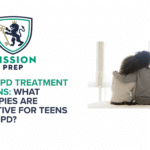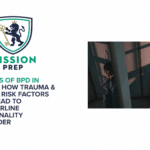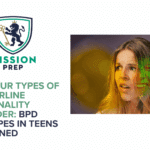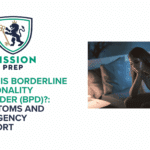BPD vs Bipolar in Teens: Key Differences & Similarities


Roughly one in every five youths in the U.S. experience a mental health disorder, with mood regulation disorders among the most commonly misdiagnosed.¹
For teens navigating emotional swings in adolescence, distinguishing between borderline personality disorder (BPD) and bipolar disorder can be complex. Both can involve intense moods, impulsivity, and changes in behavior, but they stem from different underlying processes and require unique forms of support.² For these reasons, understanding the difference between BPD and bipolar, especially in teens, is critical for early intervention and effective care.
If you’re a teen with BPD or bipolar disorder, or a parent trying to provide care, you’re bound to have questions you want answered. A mental health professional can help, but this guide also aims to cover:
- A comparison between BPD and bipolar disorder in teens
- How BPD and bipolar disorder are diagnosed
- Treatment differences between BPD and bipolar disorder
- How Mission Prep can help with psychiatric evaluations for teens
Teen Mood Disorder Comparison: BPD vs Bipolar in Teens
Borderline personality disorder (BPD) and bipolar disorder can look similar at first glance, especially during adolescence, when emotional ups and downs are already part of daily life.
BPD in teens often shows up as intense emotional reactions to things happening in relationships, like a friend pulling away, a family conflict, or even a minor change in plans. These mood swings are typically fast, and usually tied to fear of abandonment or not knowing who they are.³
Bipolar disorder in teens, on the other hand, involves bigger shifts in mood that don’t always have an outside trigger.⁴ For instance, a teen might go from a deep, unshakable depression to feeling wired, invincible, or impulsive during a manic episode. These mood changes usually last longer than those in BPD and follow a more cyclical pattern.
Brain Chemistry: What’s Going On in BPD vs Bipolar?
In bipolar disorder, the brain’s mood regulation system goes through dramatic chemical shifts. During a manic episode, there’s often too much dopamine and norepinephrine, which are the brain’s “go” chemicals.⁵
An increase in these chemicals can lead to racing thoughts, high energy, and risky behavior. In depressive episodes, these same chemicals dip too low, causing fatigue, sadness, and hopelessness. These shifts also tend to happen in cycles, often without an obvious external trigger.
In borderline personality disorder, the brain responds intensely to emotional situations, especially social stress.⁶ Teens with BPD often have a highly sensitive amygdala (the brain’s alarm system), which reacts strongly to perceived threats or rejection.
At the same time, the prefrontal cortex (which helps with impulse control and emotional regulation) may struggle to calm the alarm system down. Therefore, emotions can feel overwhelming and hard to manage, even during everyday interactions.
Unlike bipolar, BPD emotional shifts are typically short-lived and closely tied to what’s happening in the teen’s environment or relationships.
The following is a clear breakdown of the BPD vs bipolar in teens comparison and what shows on the surface.
BPD vs Bipolar in Teens Comparison Breakdown:
What triggers mood shifts?
- BPD: Triggers are usually social or emotional, like a fight with a friend
- Bipolar: There’s often no clear trigger – mood shifts can happen on their own
How fast do moods change? ⁷
- BPD: Emotions can shift in minutes or hours
- Bipolar: Mood episodes usually last days or even weeks
What does the teen feel during “highs”?
- BPD: Anxious, reactive, overwhelmed
- Bipolar: Energized, grandiose, impulsive (during mania or hypomania)
What’s happening with identity?
- BPD: Often, there’s an ongoing struggle with self-image, such as not knowing who they are
- Bipolar: Identity usually remains stable between mood episodes
Are behaviors the same?
- Not always. Both BPD and bipolar can include risk-taking, sleep issues, and emotional swings, but the why behind the behavior matters most
Diagnosing BPD vs Bipolar
When a teen shows signs of intense emotions or unpredictable behavior, families often wonder if it’s just teen moodiness or something more serious. A proper diagnosis starts with a detailed evaluation by a licensed mental health professional.
During a youth psychiatric evaluation, the clinician will typically begin by gathering a full history. This includes questions about emotional patterns, behavior at school, relationships, family dynamics, and any history of trauma or self-harm. Since the difference between BPD and bipolar can be subtle, this stage is essential.
Here’s what families can generally expect during the diagnostic process:
Structured Clinical Interviews
The SCID-5-PD (Structured Clinical Interview for DSM-5 Personality Disorders) and K-SADS (Kiddie Schedule for Affective Disorders and Schizophrenia) are often used to identify core symptoms and rule out other conditions. These help differentiate between BPD vs bipolar in teens by tracking symptoms over time and across contexts.
Mood Tracking and Behavior Observation
Teens may be asked to journal or report patterns of behavior, mood shifts, and triggers. This helps distinguish between bipolar episodes vs BPD triggers, since the former often come in cycles, while the latter are more reactive and tied to relationships.
Self-Report Questionnaires
Tools like the Borderline Personality Features Scale for Children (BPFS-C) or Mood Disorder Questionnaire for Adolescents (MDQ-A) can give insight into how the teen experiences their emotions. These can support early recognition of teenage bipolar symptoms or adolescent borderline traits.
Input from Caregivers and Schools
Context is important when it comes to diagnosing BPD and bipolar disorder. Consulting with teachers and parents gives clinicians a deeper understanding of the emotional swings the teen is experiencing. Misdiagnosis is always something that professionals aim to be mindful of, so the process is never rushed. For instance, some teens initially diagnosed with bipolar disorder are later found to have BPD, or vice versa.
Diagnosing mood regulation disorders requires careful attention to symptoms over time and a nuanced understanding of youth personality vs mood disorders. When done properly, it creates a foundation for the most effective treatment plan.
Treatment Differences for BPD and Bipolar
BPD and bipolar disorder both can have a dramatic impact on someone’s behavior and emotions. But these impacts are the result of different things happening in the brain and body. This difference means that each condition requires a different treatment approach.
Bipolar disorder is the result of brain chemistry changes that create cycles of mania and depression. In contrast, BPD is involves chronic emotional dysregulation patterns, unstable self-image, and difficult relationships. Many of these issues stem from early attachment wounds and trauma.
The paths to healing from BPD and bipolar disorder look different, as we’ll discuss next.
Treating Bipolar Disorder in Teens
Medication is a central part of bipolar treatment. This is because bipolar episodes, especially manic or hypomanic states, arise from shifts in neurochemistry that can’t often can’t be addressed through therapy alone.
Bipolar disorder treatment often involves:
- Medication: Medication can help reduce how often and extreme mood swings are.⁸ Therefore, mood stabilizers and antipsychotics are often prescribed to help manage manic and depressive episodes.
- Structured routines: Helping teens develop healthy daily routines like regular sleep and meal times can reduce and prevent mood destabilization.⁹
- Therapy: Various forms of therapy, like CBT (cognitive behavioral therapy) and DBT (dialectical behavioral therapy) can help teens recognize early signs of mood shifts. They can also develop coping skills for working through depressive episodes or impulsive thoughts and behavior.¹⁰
- Education for families: Family can play a role in identifying signs of mania or depression and can learn how to respond supportively
Bipolar disorder isn’t caused by life stress or relational dynamics, though these can make symptoms worse. Instead, it requires managing internal cycles that may continue even when life seems calm.
Treating Borderline Personality Disorder in Teens
BPD treatment focuses less on regulating mood states and more on strengthening emotional resilience, identity stability, and relationship skills. Medications may be used to treat co-occurring anxiety or depression, but they don’t target the core patterns of BPD.
Core BPD treatments include:
- Dialectical behavior therapy (DBT): DBT is designed specifically for BPD and helps teens manage emotional surges, build distress tolerance, and develop safer coping strategies.¹¹
- Somatic therapy: This type of therapy addresses how emotion lives in the body, helping teens tune into physical cues, calm their nervous system, and feel more grounded.¹²
- Narrative and identity-focused work: Supports teens as they explore who they are, what they value, and how to hold a stable sense of self over time.¹³
- Family involvement: BPD education for parents can help them learn how to support teens through emotional dysregulation without escalating conflict.
Bipolar disorder has very distinct phases that show up. On the other hand, BPD is a fast-moving emotional response that’s triggered by certain beliefs, including fear of abandonment and rejection. For this reason, treatments for BPD center on creating inner stability and trust rather than simply targeting symptoms with medication.
Understanding these treatment differences between BPD and bipolar helps families avoid trial-and-error interventions and gives teens a more supportive path forward. Even when symptoms seem to overlap, the clinical goals are different: chemical regulation for bipolar; emotional and relational integration for BPD.

Contact Mission Prep for Youth Psychiatric Evaluation
Some teen behaviors are just part of growing up. Others feel heavier and more persistent and intense. If you’re noticing strong emotional reactions, shifts in mood, or changes that don’t pass with time, it might be worth looking a little deeper.
At Mission Prep, we offer careful, developmentally informed psychiatric evaluations designed for adolescents. These assessments don’t just check off symptoms. They explore the full pictur, like emotional patterns, family dynamics, identity development, and how a young person responds to their environment. Our focus is understanding, not just diagnosing.
Distinguishing between BPD and bipolar disorder takes time, care, and the right lens. If you’ve been wondering whether what you’re seeing is typical or something more, contact our team to figure out the next steps.
References
- Merikangas, K. R., He, J.-P., Burstein, M., Swanson, S. A., Avenevoli, S., Cui, L., Benjet, C., Georgiades, K., & Swendsen, J. (2010). Lifetime prevalence of mental disorders in U.S. adolescents: Results from the National Comorbidity Survey Replication–Adolescent Supplement (NCS-A). Journal of the American Academy of Child and Adolescent Psychiatry, 49(10), 980–989. https://pmc.ncbi.nlm.nih.gov/articles/PMC2946114/
- Ruggero, C. J., Zimmerman, M., Chelminski, I., & Young, D. (2010). Borderline personality disorder and the misdiagnosis of bipolar disorder. Journal of Psychiatric Research, 44(6), 405–408. https://pmc.ncbi.nlm.nih.gov/articles/PMC2849890/
- Chapman, J., Jamil, R. T., Fleisher, C., & Torrico, T. J. (2025). Borderline personality disorder. In StatPearls. StatPearls Publishing. https://www.ncbi.nlm.nih.gov/books/NBK430883/
- National Institute of Mental Health. (n.d.). Bipolar disorder in children and teens. Retrieved July 14, 2025, from https://www.nimh.nih.gov/health/publications/bipolar-disorder-in-children-and-teens
- Lee, J. G., Woo, Y. S., Park, S. W., Seog, D.-H., Seo, M. K., & Bahk, W.-M. (2022). Neuromolecular etiology of bipolar disorder: Possible therapeutic targets of mood stabilizers. Clinical Psychopharmacology and Neuroscience, 20(2), 228–239. https://www.cpn.or.kr/journal/view.html?doi=10.9758/cpn.2022.20.2.228
- Dixon-Gordon, K. L., Peters, J. R., Fertuck, E. A., & Yen, S. (2017). Emotional processes in borderline personality disorder: An update for clinical practice. Journal of Psychotherapy Integration, 27(4), 425–438. https://pmc.ncbi.nlm.nih.gov/articles/PMC5842953/
- Mneimne, M., Fleeson, W., Arnold, E. M., & Furr, R. M. (2018). Differentiating the everyday emotion dynamics of borderline personality disorder from major depressive disorder and bipolar disorder. Personality Disorders: Theory, Research, and Treatment, 9(2), 192–196. https://pmc.ncbi.nlm.nih.gov/articles/PMC5708157/
- Jing, P., Su, J., Zheng, C., Mei, X., & Zhang, X. (2023). A retrospective study of psychotropic drug treatments in bipolar disorder at acute and maintenance episodes. Frontiers in Psychiatry, 14, 1057780. https://pmc.ncbi.nlm.nih.gov/articles/PMC9942488/
- Murray, G., Gottlieb, J., & Swartz, H. A. (2021). Maintaining daily routines to stabilize mood: Theory, data, and potential intervention for circadian consequences of COVID-19. Canadian Journal of Psychiatry, 66(1), 9–13. https://pmc.ncbi.nlm.nih.gov/articles/PMC7890582/
- Zargar, F., Haghshenas, N., Rajabi, F., & Tarrahi, M. J. (2019). Effectiveness of dialectical behavioral therapy on executive function, emotional control and severity of symptoms in patients with bipolar I disorder. Advanced Biomedical Research, 8, 59. https://pmc.ncbi.nlm.nih.gov/articles/PMC6796294/
- May, J. M., Richardi, T. M., & Barth, K. S. (2016). Dialectical behavior therapy as treatment for borderline personality disorder. The Mental Health Clinician, 6(2), 62–67. https://pmc.ncbi.nlm.nih.gov/articles/PMC6007584/
- Schmaling, K. B., Fales, J. L., & Linehan, M. M. (2021). Treatment for borderline personality disorder and secondary effects on somatization. Journal of Personality Disorders, 35(4), 632–640. https://pubmed.ncbi.nlm.nih.gov/31990615/
- Steuwe, C., Berg, M., Beblo, T., & Driessen, M. (2021). Narrative exposure therapy in patients with posttraumatic stress disorder and borderline personality disorder in a naturalistic residential setting: A randomized controlled trial. Frontiers in Psychiatry, 12, 765348. https://pmc.ncbi.nlm.nih.gov/articles/PMC8663140/



















